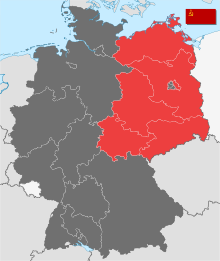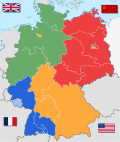Soviet occupation zone in Germany
| Soviet occupation zone in Germany Sowjetische Besatzungszone Советская оккупационная зона Германии | |||||||||||
|---|---|---|---|---|---|---|---|---|---|---|---|
| Military occupation zone of the Soviet Union | |||||||||||
 The Soviet occupation zone in red | |||||||||||
| Capital | Berlin | ||||||||||
| Government | |||||||||||
| • Type | Military occupation (member of the Eastern Bloc) | ||||||||||
| Military governors | |||||||||||
• 1945–1946 | Georgy Zhukov | ||||||||||
• 1946–1949 | Vasily Sokolovsky | ||||||||||
• 1949 | Vasily Chuikov | ||||||||||
| Historical era | Post-World War II Cold War | ||||||||||
| 8 May 1945 | |||||||||||
• German Democratic Republic established | 7 October 1949 | ||||||||||
| |||||||||||
| Today part of | Germany | ||||||||||
The Soviet occupation zone in Germany (

The SBZ was one of the four
By the time armed forces of the United States and United Kingdom began to meet Soviet Union forces, forming the Line of Contact, significant areas of what would become the Soviet zone of Germany were outside Soviet control. After several months of occupation, these gains by the British and Americans were ceded to the Soviets by July 1945, according to the previously agreed occupation zone boundaries.
The SMAD allowed four
The SMAD set up


In 1945, the Soviet occupation zone consisted primarily of the central portions of Prussia. After Prussia was dissolved by the Allied powers in 1947, the area was divided between the German states (Länder) of Brandenburg, Mecklenburg, Saxony, Saxony-Anhalt and Thuringia.[2] On 7 October 1949, the Soviet zone became the German Democratic Republic. In 1952, the Länder were dissolved and realigned into 14 districts (Bezirke), plus the district of East Berlin.
In 1952, with the Cold War political confrontation well underway, Joseph Stalin sounded out the Western Powers about the prospect of a united Germany which would be non-aligned (the "Stalin Note"). The West's lack of interest in this proposal helped to cement the Soviet Zone's identity as the GDR for the next four decades.
"Soviet zone" and derivatives (or also, "the so-called GDR") remained official and common names for East Germany in West Germany, which refused to acknowledge the existence of a state in East Germany until 1972, when the government of Willy Brandt extended a qualified recognition under its Ostpolitik initiative.
See also
- Allied-occupied Austria
- History of East Germany
- Bizone
- Trizone
- Group of Soviet Forces in Germany
- Stunde Null
References
- ISBN 9780880331746.
- OCLC 38207545.
- Brennan, Sean, 'Land Reform Propaganda in Soviet Occupied Germany', University of Kent
- Lewkowicz, NicolasThe German Question and the International Order, 1943–48 (Palgrave Macmillan: Basingstoke and New York) (2008)
- Lewkowicz, Nicolas, The German Question and the Origins of the Cold War (IPOC: Milan) (2008)



